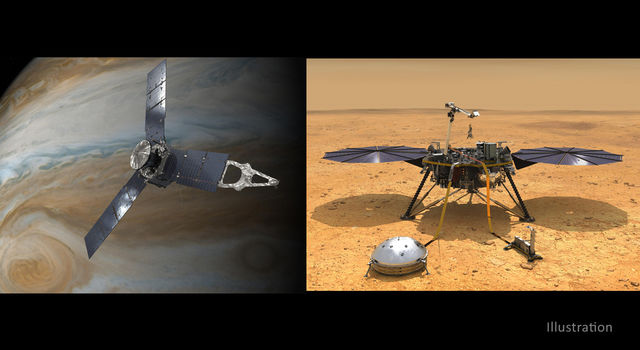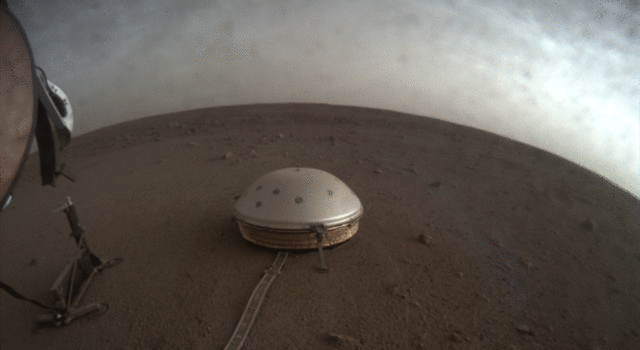Blogs | Dawn Journal | October 7, 2007
October 7, 2007
Dear Xedawnions,
Joining an elite club among spacecraft, Dawn successfully fired up its xenon ion propulsion system on October 6. This important milestone in Dawn’s 80-day checkout phase followed ongoing work by the mission operations team members to become accustomed to flying this new spacecraft, as they continue monitoring telemetry, adjusting onboard parameters, and conducting special activities to keep the spacecraft performing smoothly.
The ion propulsion system (in the interest of environmental responsibility, we will conserve keystrokes in this log by using the acronym IPS) will be used to climb away from the Sun, pass Mars, rendezvous with Vesta, maneuver into different orbits around it to provide the science instruments with varied views of the alien world, leave orbit, push still deeper into space to dwarf planet Ceres, and orbit it for the same scientific scrutiny. All systems on the spacecraft are complex and important (the relative importance was considered on September 17, 2006 and October 29, 2006), but the IPS has been the focus of the Dawn team in recent days.
While the 3 ion thrusters are the most familiar part of the IPS, they are not its only elements. The system includes 2 computer controllers (only 1 is used at a time). When mission control selects 1 of the 112 throttle levels (each corresponding to a certain power consumption and thrust), the operating controller translates the command into the currents and voltages that must be applied to parts of the thruster and the flow rate of xenon propellant to the thruster. The controller also provides the principal communications between the main spacecraft computer and the rest of the IPS, accepting commands and reporting on the IPS performance. While the controller is the brain of the system, the 2 power units (again, only 1 is used at a time) are the brawn. Following instructions from the controller, a power unit receives power from the solar arrays at about 100 volts and converts it to more than 1000 volts for use by the thruster.
On October 2, a controller and a power unit were activated and verified to be operating correctly. When that was complete, those devices were turned off and the other ones were powered on and checked out.
The 3 ion thrusters are mounted on different parts of the spacecraft. The one located along the central axis of the spacecraft (at the “bottom” in many depictions) is known affectionately as thruster #3, and that was the focus of this past week’s tests. The thruster near the visible and infrared mapping spectrometer (on what might be considered the “back” of the spacecraft) is thruster #1. Given that sophisticated nomenclature, the astute reader might presume that the thruster near the main antenna (on the “front” of the spacecraft) is thruster #2. As our readers are well known all to be astute, it will be no surprise that indeed that is its designation.
Each thruster is mounted to a gimbal system that allows the direction it is pointed to be changed by a few degrees. The angle is not large; the total range corresponds to less than the movement of the minute hand of a clock in 3 minutes. While the purpose of IPS is thrusting is to propel the spacecraft in its orbit (around the Sun now, and later around Vesta or Ceres), the attitude control system uses the thrust as one of its means to control the spacecraft’s orientation by slowly swiveling the thruster. The gimbal for thruster #3 was commanded to execute a preprogrammed set of movements on October 2, and its health was verified.
Some of the components in the thrusters are very sensitive to contamination, particularly water. While every effort was made to prevent air, and its normal inventory of water vapor, from becoming trapped in the system while on Earth, it is inevitable that some stray molecules of water would be in the stainless steel lines that deliver xenon to the thrusters and in the thrusters themselves. To reduce the presence of contaminants, several days of activities were devoted to purging the system by baking it out. Around noon PDT on October 2, mission controllers transmitted commands to raise some parts of the spacecraft to about 50°C (approximately 120°F). The temperatures were restored to normal values 30 hours later.
As most space enthusiasts know, October 4 was the 50th anniversary of the launch of Sputnik 1 and, quite remarkably given the different calendric system, the 5,000,050th anniversary of the first mission to the eventual site of the Tribute to Coincidence. The Dawn project recognizes with great admiration those missions and all others that have ventured into space in the pursuit of knowledge and the spirit of exploration. As the Dawn team prepared for the day’s activity, 7 days after launch, the spacecraft was almost 2300 times farther from Earth than Sputnik 1 was at its maximum range. Yet Dawn’s journey is still just beginning, and its travels should take it more than 250 times still farther from home.
To ionize its propellant, the thruster bombards the xenon atoms with electrons, as explained on December 28, 2006. The device that emits electrons was heated for several hours on October 4 as another step in preparing the thruster for operation.
The last operation before thrusting, undertaken on October 5, was to ionize xenon inside the thruster but not accelerate the propellant, obliging the IPS to do almost everything required for normal thrusting.
Because the thrust is so gentle, there are no sensors on board that directly measure it. To verify that the thruster performs as expected, the remarkable accuracy of the techniques of deep-space navigation are employed. With measurements of the change in the frequency (or pitch) of the radio signal, engineers can calculate the change in the spacecraft’s speed. This capability relies on the Doppler effect, which is familiar to most terrestrial readers as they hear the pitch of a siren rise as it approaches and fall as it recedes. Other readers who more commonly travel at speeds closer to that of light recognize that the well-known blueshift and redshift are manifestations of the same principle, applied to light waves rather than sound waves. Although like all spacecraft built by humans, Dawn’s speed is only a tiny fraction of the speed of light, with the astonishing sensitivity of the Doppler measurements, the gradual effect of the thrusting can be sensed. With the spacecraft coasting away from Earth at more than 3.3 kilometers per second (7400 miles per hour), the radio measurements can detect changes smaller than 0.5 millimeters per second (less than 6 feet per hour). Snails, take note.
Others take note that the speed relative to Earth is most assuredly not the speed relative to the Sun. The spacecraft is in its own orbit around the Sun, and at this point in the mission, it is traveling at about 33.1 kilometers per second (74,000 miles per hour) in that orbit. This writer and others on his homeworld are orbiting the Sun at 29.8 kilometers per second (66,700 miles per hour). The difference is the speed at which Dawn is leaving Earth.
The Doppler effect applies only for motion toward or away from the observer; movement across the line of sight does not change the pitch of the signal. Therefore, to maximize the effect in the test of the IPS, the thruster should propel the spacecraft toward or away from Earth. With the present relative positions of Earth, our favorite interplanetary probe, and the Sun, when thruster #3 is pointed toward Earth, the incident sunlight, in combination with the heat generated by the operation of the thruster itself, would cause the unit to overheat. With the thruster pointed directly away from Earth, the temperature is fine. That has the curious consequence of engineers choosing to propel the spacecraft toward Earth during the first thrust test.
The objective of all the thrusting during the first 80 days of the mission is not to change the spacecraft’s trajectory but rather to evaluate the performance of all systems and prepare for the thrusting after this checkout phase. As the effect of the ion propulsion only becomes significant after long intervals, the short thrust periods for testing do not cause important changes in the trajectory.
On October 6, the mission control team instructed Dawn to turn to point thruster #3 away from Earth. Following that, and after one final verification that all onboard systems were healthy and ready for the next step, the command to initiate thrusting was sent. The drama was captured in the stirring name of the file that was transmitted to the spacecraft: dz002e.scmf. (Our readers who are not versed in neutron star orbital opera may not fully appreciate the drama of that name and are requested to accept that others may find great passion in the command file name.)
In the silent depths of space, far from its designers and controllers, connected to Earth only by the faintest whisper of a radio signal, Dawn dutifully executed the programmed steps. The craft had no appreciation of the hopefulness of its terrestrial handlers as it began emitting a bluish beam of xenon ions at 6:07 pm PDT.
When data revealing the thruster’s electrical currents and voltages showed up in mission control, the excitement remained controlled but was clearly rising much much faster than the gradual acceleration of the spacecraft. Experienced team members, huddled around the monitors in mission control, kept in mind that while starting thrusting was wonderful progress, success required sustaining it. Within 5 minutes though (in fact, shortly after 4.5 minutes for team members who also worked on Deep Space 1), the enthusiasm could no longer be contained, as all indications were that Dawn was quite content to keep thrusting.
Much of the joy was in sharing the success with colleagues who have worked very very hard together for years, each perhaps with his or her own personal motivations and rewards, but each contributing to a common goal of pushing the frontiers of space exploration. Still more of the happiness is in sharing the accomplishment with supportive family members and friends -- and loyal readers! While, like launch, this is but one more step in Dawn’s very long journey to unlock the secrets of Vesta and Ceres, it is an important one, and the many feelings of having a probe in powered flight in deep space are all -- well, perhaps “out of this world” is the best descriptor.
The test sequence operated the IPS at throttle level 28 (in the range from 1 to 112) for nearly 12 hours. Next, it throttled up to level 49, and then it pushed still higher every 4 hours after that, operating at levels 70, 91, and finally 112. Thrust was commanded off on October 7 at 7:12 pm as the test completed successfully. In about 25 hours of thrusting, the acceleration amounted to 3.6 meters per second (8 miles per hour), truly negligible compared to the spacecraft’s speed relative to Earth or the Sun.
After the checkout phase, except in special circumstances, Dawn always will use the highest throttle level it can. As it travels farther from the Sun, eventually its enormous solar arrays, the most powerful ever used on an interplanetary spacecraft, will not produce enough power to permit operation at level 112, so the IPS will be throttled down. That is why it is necessary to certify operation over a range of throttle levels.
In addition to the Doppler measurements to reveal the thrust, engineering data were collected on the performance of the IPS, attitude control system, electrical power system, thermal control system, and all other onboard participants in the thrusting. More tests are ahead for thruster #3 as well as the other thrusters and other spacecraft systems.
Dawn is 3.21 million kilometers (2.00 million miles) from Earth or more than 8 times farther than the moon. Radio signals, traveling at the universal limit of the speed of light, take more than 21 seconds to make the round trip.
Dr. Marc D. Rayman
10:00 pm PDT October 7, 2007
TAGS:DAWN, VESTA, CERES, DWARF PLANET, MISSION, SPACECRAFT







